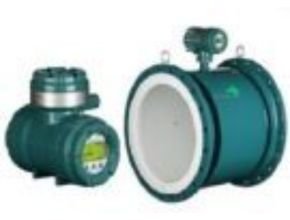The Kobold DOR series insertion paddle wheel flow sensor is a very cost-effective instrument for accurately measuring the flow of water or water-like liquids in large pipes. The sensor is inserted into the process piping via a thread-o-let or half-nipple fitting. Liquid flow through the pipe results in the rotation of the affixed paddle wheel. The rotational speed of the paddle is proportional to the flow velocity, and therefore, proportional to the flow rate in the pipe.
The insertion-type design provides a measuring technique that is much less expensive than full-bore flowmeters, especially in larger pipe sizes. Insertion paddle wheel sensors are a robust measuring technology that boasts exceptional tolerance to dirt and solids. The DOR series features an all 316L stainless steel body. The rotor is made of PVDF or PEEK, with a long-life, graphite/ PTFE self-lubricating bearing.
The DOR has an integral, precision insertion mechanism that allows the installer to insert the rotor to the precise depth in the pipe for optimal readings. Outputs include NPN open collector frequency, and/or reed contact frequency. Optional indicators include battery-powered totalizers, loop-powered ratemeters/totalizers, and batch controllers. The DOR-5 is suitable for “hot tap” installation. With its symmetrical design, the DOR may be used for bi-directional flow measurement.
Specification
- Measuring range: 0.25 – 6300 l/s … 0.4 – 49000 l/s
- Flow velocity range: 0.3 – 10 m/s
- Connection: R 1½, R 2, 1½” NPT, 2″ NPT male thread for pipe sizes DN40 … DN2500
- Material: stainless steel
- pmax: 80 bar
- tmax: 150°C
- Linearity: ±1.5 %
Kobold DOR Applications
- HVAC: Hot and Chilled water, Fire system, and thermal energy monitoring
- Municipal: Water distribution, water management, and water treatment
- Irrigation: Water management
- Water treatment: Chlorination, de-salination and mechanical filtration plants, chemical injection systems
- Refineries: Primary flow additive injection, fire, and cooling systems
- Power generation: Boiler feed water, steam condensate, process water, and water balancing
- Chemical: Process & cooling tower water, chemical, and water batching
- Others: Cement manufacturing, diesel fuel transferring, flow testing, fire truck and hydrant flow monitoring, food processing, pulp/paper, mining
Kobold DOR Specifications
- Velocity measuring range (linear):
0.3…10 m/s equates to approx.
0.25…49,000 l/s in DN40 to DN2500 pipes;
0.15…10 m/s when using the linearisation function of electronic type ZOK-Z3 or ZOE - Linearity: ±1.5% with well est. flow profile
- Repeatability: ±1% of f. s. at factory conditions and optimal straight runs
- Max. pressure: 80 bar
- Temperature range: -40…+100°C standard, see max. allowable medium temperature table for other options and restrictions
Material
- Body: stainless steel 1.4404 (316L)
- Rotor: PVDF or PEEK (depending on model)
- Rotor shaft: stainless steel 1.4404 (316L)
- Bearing: graphite/PTFE
- Seals:
FPM (standard): -15…+200°C
NBR (Nitril): -65…+125°C
Electronics
- Output frequency at max. velocity: 220…240 Hz (hall effect and voltage output), 73…80 Hz (reed switch output)
- Supply voltage: see electrical output specifications and electronics comparison table
- Electronic features: see data sheet ZOK (only available as remote version)
- Wiring (standard): 5 core, screened cable, length, 1 m (DOR-52), 1.5 m (DOR-42)
- Transmission distance: 1000 meters maximum
- Protection class: IP68 (cable connection)
- Straight piping requirement: Minimum: 10xd (upstream), 5xd (downstream)
- Optimal: 25xd (upstream), 10xd (downstream)
- Weight: (approx., without electronics): 1.6 kg (DOR-4), 2.5 kg (DOR-5)
Electrical Output Specifications
Hall Effect Sensor Output (FX, NX, QX)
The Hall Effect Sensor is a high-resolution solid-state 3 wire device providing an unsourced, open collector, NPN transistor output. The term “unsourced” means that no voltage is applied to the output from within the flowmeter. It must be pulled to a ‘high’ or ‘on’ state by between 5-24VDC supplied from an external source, typically the receiving instrument.
The pulse output between the signal and -0V is a voltage square wave with the high level being the DC voltage available at the open collector and the low-level being -0V. The receiving instrument must incorporate a pull-up resistor (typically greater than 10k? in most instruments) which ties the open collector to the available DC voltage level when the Hall sensor is not energized. When energized the open collector output is pulled to the ground through the emitter (-0V). Power supply: max. 5-24 VDC, max. 20 mA
Voltage Pulse Output (FX)
A self-generating 2-wire voltage pulse output with a 1.5 V voltage spike of approximately 10 microseconds duration is generated with no dependence on rotor speed.
Reed Switch Pulse Output (RX)
The reed switch output is a two-wire normally open SPST voltage-free contact ideal for installations without power or for use in hazardous area locations (simple apparatus) when Intrinsically Safe (I.S.) philosophy is adopted. Note: when using the reed switch output the liquid temperature must not change at a rate greater than 10ºC per minute. In general, the reed switch life will exceed 2 billion actuations when switching less than 5VDC at 10mA. Power supply: max. 30 VDC, 200 mA
Quadrature Pulse Output (QX)
Two Hall Effect sensors are arranged to give separate outputs out of phase with one another. The Quadrature output is typically suited to ensure output signal integrity or to measure bi-directional flow. Power supply: max. 8-24 VDC, max. 20 mA
NPN Inductive Pick-up (EX)
Inductive pick-up with non-magnetic rotor for applications with high ferrous content liquids. Output is 3-wire NPN, 5-24 VDC, 20 mA max.
Download Datasheet: Kobold DOR Insertion Paddle Wheel Flowmeter/Monitor
Reference : kobold.com
Another Article:
- Kobold Display, Indicator, and Control
- IP100/200 Paddle Wheel Flow Meter
- Kobold Flow Measurement
- Kobold Level Meter and Valve





